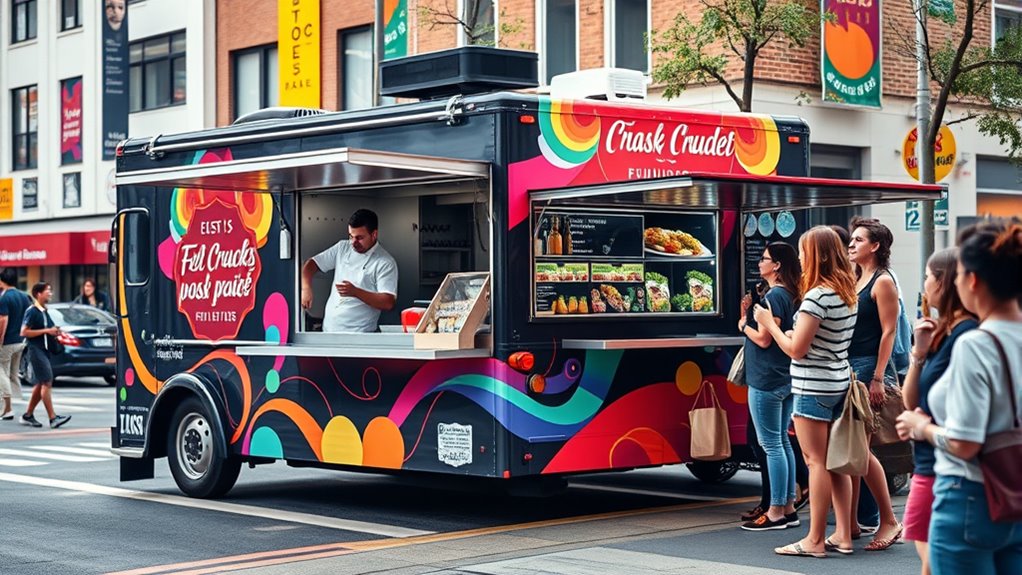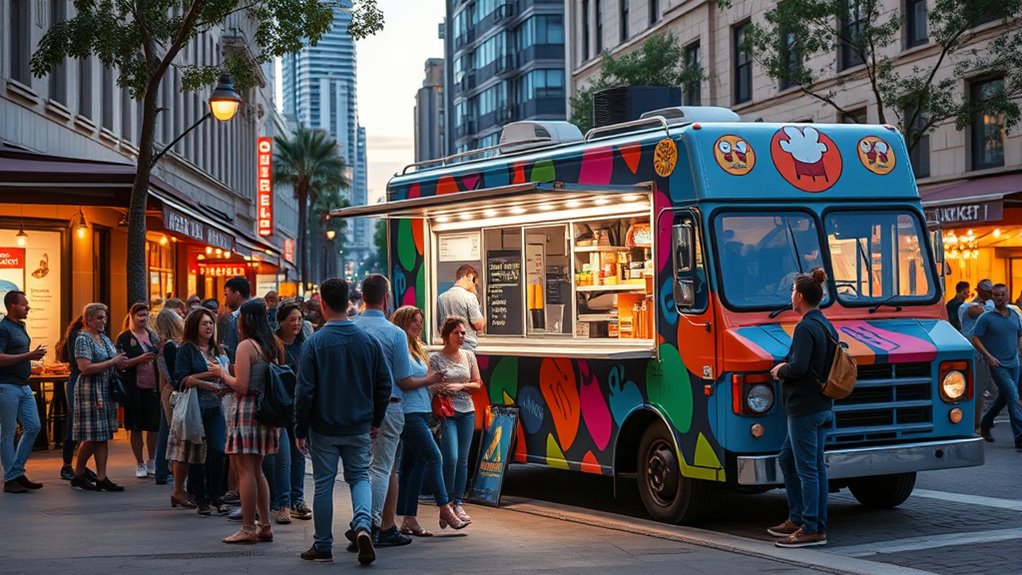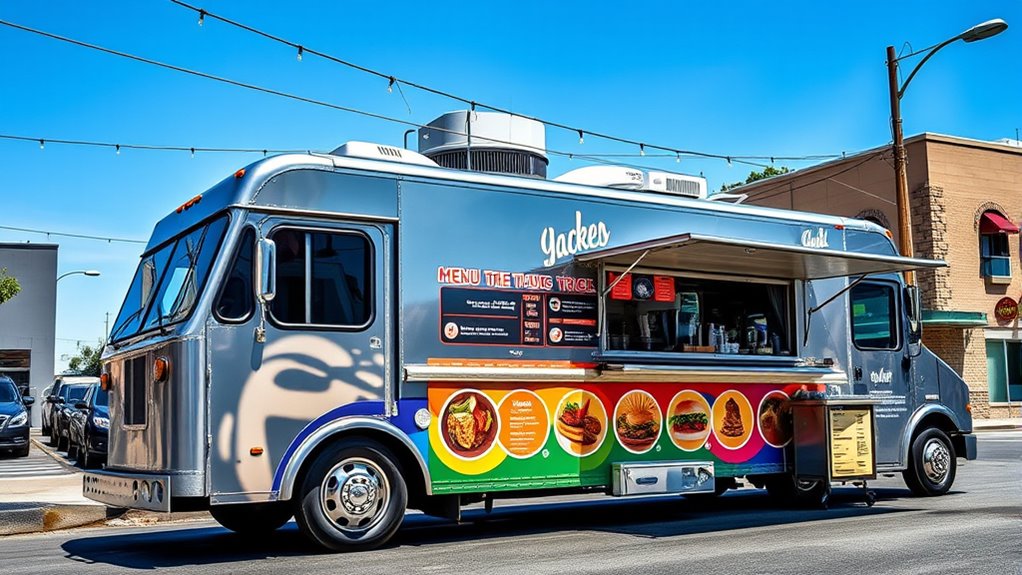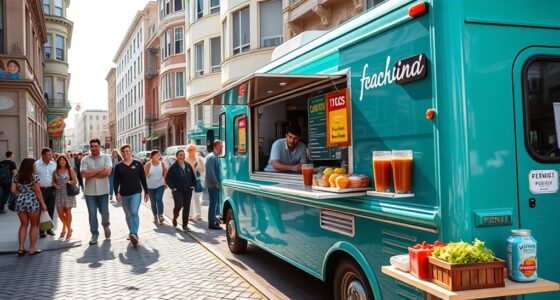To choose the perfect food truck concept, start by aligning your passion and expertise with menu ideas that excite you and match your skills. Conduct market research to identify current trends and uncovered gaps, ensuring your offering stands out. Consider practical costs, equipment, and the location’s visibility. Test your ideas with samples and gather honest feedback. By planning for growth and adaptability, you’ll set a strong foundation—continue exploring to learn the steps to turn your vision into reality.
Key Takeaways
- Align your passion and expertise with a food concept that excites you and suits your skills.
- Conduct thorough market research to identify current trends, customer preferences, and unmet niche opportunities.
- Evaluate costs and select equipment that is reliable, scalable, and fits your budget for sustainable growth.
- Develop a clear branding strategy to differentiate your truck and foster customer loyalty across locations.
- Test your menu with samples and gather feedback to refine flavors, presentation, and ensure market fit.
Assess Your Passion and Expertise

Before choosing a food truck concept, understanding your passion and expertise is vital because your enthusiasm and skills will drive your success. When you focus on passion alignment, you’re more likely to stay motivated during tough times and create a menu you genuinely enjoy. Think about what foods excite you and where your skills lie—whether it’s grilling, baking, or international cuisine. Skill development is key; selecting a concept that matches or enhances what you already know helps you serve quality dishes efficiently. By aligning your passion with your expertise, you’ll build a strong foundation for your business. This focus guarantees you’re genuinely invested, making it easier to innovate, improve, and connect with your customers authentically.
Research Market Trends and Demographics

Understanding current market trends and demographics is essential to choosing a food truck concept that will thrive. By analyzing consumer preferences, you can identify the types of cuisine and dining experiences your target audience values most. Conducting competitor analysis helps you see what other food trucks are offering and where opportunities may exist. Pay attention to popular food trends, local taste preferences, and demographic data such as age, income, and lifestyle. This information guides you in selecting a concept that appeals to your potential customers and differentiates you from competitors. Staying informed about evolving trends ensures your food truck remains relevant and competitive, increasing your chances of success in a dynamic market. Additionally, being aware of global economic fluctuations can help you anticipate shifts in consumer spending and adjust your offerings accordingly.
Identify Gaps and Unique Opportunities

You need to analyze market demand to spot unmet needs and areas with little competition. Identifying these gaps helps you understand where your food truck can stand out. By focusing on what’s missing or underrepresented, you can develop a unique offer that attracts customers. Utilizing customer feedback and reviews can provide valuable insights into niche opportunities and preferences.
Market Demand Analysis
Conducting a thorough market demand analysis helps you uncover gaps in existing food truck offerings and spot unique opportunities to stand out. By examining local preferences and customer needs, you can identify underserved niches or trending cuisines. This process also highlights opportunities for ingredient sourcing, such as sourcing specialty or locally-sourced ingredients that competitors overlook. Additionally, it encourages menu innovation, allowing you to create dishes that fill unmet demands or introduce fresh concepts that excite customers. Understanding what’s missing in the current market enables you to tailor your food truck concept to meet specific demands and stand apart from others. This strategic insight ensures your offerings resonate with your target audience, increasing your chances of success in a competitive landscape. Incorporating insights from sound design techniques can also inspire creative presentation and branding to make your food truck truly memorable.
Differentiating Your Offer
To truly stand out in a crowded food truck market, it is vital to identify gaps in existing offerings and uncover unique opportunities. Start by analyzing competitors’ menus and branding strategies to find areas where you can innovate. Think about menu innovation—introduce unique flavors, dietary options, or fusion concepts that set you apart. Strong branding strategies help communicate your uniqueness and attract loyal customers. Look for underserved niches or emerging food trends that align with your passion and expertise. By focusing on what others haven’t tapped into, you create a distinctive identity that resonates. Incorporating vetted products or safe ingredients can also enhance your credibility and appeal. Differentiating your offer through creative menu items and compelling branding makes it easier to carve out your space and build a memorable presence in the busy food truck scene.
Consider Practical Aspects and Costs

Considering practical aspects and costs is essential when choosing a food truck concept, as these factors directly impact your success and profitability. First, evaluate your budget to determine the most cost-effective equipment that meets your needs without overspending. Second, prioritize location selection, as high-traffic areas can boost sales but may come with higher costs or permits. Third, consider ongoing expenses like maintenance, staffing, and supplies, which affect your bottom line. Focusing on economical equipment ensures you don’t drain resources early on, while smart location choices maximize visibility and customer flow. Additionally, understanding projector technology can help you choose durable and reliable equipment that enhances your service quality. Balancing these practical aspects helps you develop a sustainable, profitable concept that aligns with your financial capacity and business goals.
Test Your Concept and Gather Feedback

Once you’ve outlined your food truck concept and set your practical plans, it’s time to test your idea in real-world settings. Conduct taste testing sessions to see how customers respond to your menu. Offer samples and observe their reactions to refine flavors and presentation. Additionally, gather feedback through customer surveys, asking about preferences, pricing, and overall experience. This direct input helps identify what works and what needs improvement before investing heavily. Be open-minded and encourage honest opinions; they’re invaluable for fine-tuning your concept. Remember, testing isn’t just about satisfying curiosity—it’s about validating your idea and ensuring it resonates with your target audience. Using market research methods during this phase can provide valuable insights into customer preferences and industry trends. Use this phase to gather insights that will shape your food truck’s success and future growth.
Plan for Scalability and Long-Term Growth

To set your food truck up for long-term success, you need a clear expansion strategy and flexible equipment design. Modular equipment allows you to adapt and grow without major overhauls, saving time and money. Planning ahead guarantees your business can scale smoothly as demand increases and new opportunities arise. Additionally, considering storage and inventory management can help maintain efficiency as your operation expands.
Modular Equipment Design
Designing your food truck with modular equipment allows you to easily adapt and expand as your business grows. This approach guarantees your setup maintains a flexible layout that can evolve with your needs. To maximize this, consider these key aspects:
- Select modular appliances that can be upgraded or replaced without overhauling your entire system.
- Arrange equipment to facilitate easy reconfiguration, enabling you to switch between menu types or add new stations.
- Invest in versatile storage solutions that support different configurations and streamline workflow.
- Incorporate scalable investment strategies that allow you to gradually expand your equipment and facilities as demand increases.
Expansion Strategy Planning
Planning for scalability and long-term growth guarantees your food truck can adjust to increasing demand and market shifts. Start by developing a clear expansion strategy that includes consistent branding, which helps build recognition and loyalty as you grow. Maintain branding consistency across all trucks, menus, and marketing materials to make sure customers identify with your concept. Effective location scouting is vital—seek high-traffic areas and emerging markets to maximize visibility. Consider how each new location aligns with your brand and operational capacity. By mapping out your growth plan now, you prepare for future opportunities and challenges. Incorporating market analysis helps you stay responsive to industry trends and customer preferences. This proactive approach ensures your food truck business remains adaptable, competitive, and positioned for long-term success.
Frequently Asked Questions
How Do I Choose a Food Truck Name That Stands Out?
To choose a food truck name that stands out, focus on branding strategies that make your name memorable. Think of catchy, unique words or puns related to your cuisine or theme, and keep it simple for easy recall. Consider your target audience and what will resonate with them. Test your ideas with friends or potential customers, and verify the name is available as a domain and on social media. A memorable name sets you apart and enhances your branding efforts.
What Licenses and Permits Are Required for a Food Truck?
Getting your food truck licensed is like steering a maze, but knowing the steps helps. You’ll need to meet food truck health regulations, obtain specific permits, and secure food truck insurance requirements. Check local health departments for health permits, and verify your vehicle complies with safety standards. You might also need a business license and parking permits. Staying organized and informed makes this process smoother and gets you on the road faster.
How Can I Effectively Market My Food Truck?
You can effectively market your food truck by leveraging social media campaigns to engage your audience and showcase your menu. Partner with local events to boost visibility and attract new customers. Use eye-catching signage and vibrant visuals to draw attention on the streets. Consistently share updates, special offers, and customer testimonials online. Building a strong presence both digitally and locally helps you create buzz and grow your loyal customer base.
What Are Common Challenges Faced by New Food Truck Owners?
As a new food truck owner, you’ll face challenges like seasonal fluctuations that impact your sales and scheduling. Equipment maintenance is also vital to keep your truck running smoothly and avoid costly breakdowns. You might struggle with managing inventory, marketing your truck, and steering through local regulations. Staying adaptable, planning ahead, and maintaining your equipment can help you overcome these common hurdles and build a successful business.
How Do I Handle Staffing and Daily Operations Efficiently?
Managing your food truck is like conducting an orchestra—every note counts. To handle staffing and daily operations efficiently, you need to master staff scheduling so everyone’s in sync. Keep a close eye on inventory management to prevent shortages or overstocking. Streamline your routines, delegate tasks, and use technology to track sales and supplies. This harmony helps your truck run smoothly, letting you focus on serving great food and growing your business.
Conclusion
Choosing the perfect food truck concept is your ticket to standing out like a neon sign in a sea of shadows. By aligning your passion, understanding market trends, and seizing unique opportunities, you’ll set yourself up for success. Test your ideas, gather feedback, and plan for growth. Remember, your food truck dream isn’t just a small idea—it’s a potential empire waiting to explode onto the scene like fireworks on the Fourth of July. Go make it happen!









